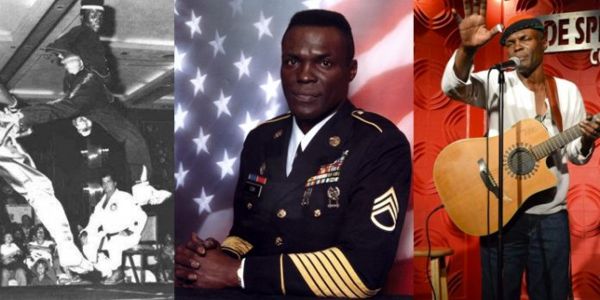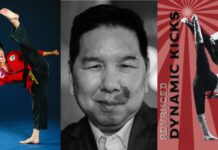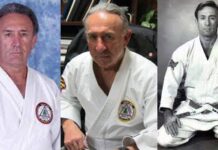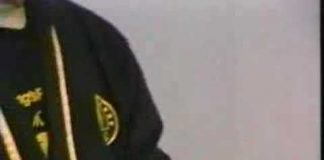Master Instructor James S. Cook Jr. started his training in 1957 at the age of 10 years old. In the past 44 years, both his training and teaching have taken him around the world.
He moved from the rugged streets of Cleveland, Ohio to Vietnam, Korea, Germany, Japan, Hawaii, Venezuela and throughout the U.S.A. A Vietnam veteran, Master Cook served 10 years in the U.S. Army as both a military police investigator and hand-to-hand combat instructor.
He has been featured in Inside Kung-Fu, Karate Illustrated, Official Karate, Who’s Who in Karate, The Pinnacle Of Karate, Masters And Founders Of The Martial Arts, Martial Arts Traditions, History, People, The Martial Arts Source boo, The Official History Of Karate In America. As well as the first black American to appear in Korean motion pictures. His accomplishments range from winning the Karate Internationals in Venezuela to being inducted into the Martial Arts Hall of Fame in Ohio.
As a Master Instructor, Mr. Cook has been sought out by some of the top names in the world of martial arts for private instruction and consultation. He teaches only that which he himself has proven to be effective, again and again. Having grown up in one of the roughest sections of Cleveland, Ohio, coupled with his tour in Vietnam, Master Instructor Cook knows about both life and death. His approach to teaching is a realistic one that leaves no stone unturned.
His circle has included some top names in martial arts: The late President of the United States Karate Association, Grand Master Robert Trias, Mr. Bill “Superfoot” Wallace, and the late Ed Parker. You will find him listed in Master Founders & Leaders of American Martial Arts. Cook’s training methods have been successful from world champion Toki Hill to champion, now actor and “Tae Bo Guru”, Billy Blanks.
PROFESSIONAL EXPERIENCE
Martial Arts Instructor:
– One on One Instruction: Nashville, TN Knoxville, TN January 1993 Present
– David Libscomb University: Nashville, TN January 1991 – 1993 Tri State Martial Arts Alliance: Nashville, TN January 1989. January 1991
– Gray Dragon Martial Arts: Nashville, TN January 1986 January 1987
– Tri State Martial Arts Academy: Steubenville, OH January 1980 January 1986
– Cleveland Academy Of Martial Arts: Cleveland, OH January 1975 December 1979
– Cuyahoga Community College: Cleveland, OH January 1975 December 1980
– United States Army: Korea, Germany, Vietnam, Ft. Bragg, NC, Ft. Meade, MD & Ft. Jackson, SC August 1965 September 1974
Education:
– 1973 Completed Broadcaster Training Taegu, Korea
– 1971 Completed Military Police Investigation School Seoul, Korea
– 1968 Completed Traffic Accident Investigation School Garmish, Germany
– 1966 Completed Military Police Training Aberdeen Proving Grounds, MD
– 1965 Completed Clerical School Ft. Jackson, SC
– 1965 Graduated Collingwood High School Cleveland, OH
Awards:
– 1981 Martial Arts Hall Of Fame Inductee
– 1980 Karate Hall Of Fame Inductee
– 1977 Top 10 Fighter in the U.S.; Official Karate Magazine
– 1977 Top 3 World Weapons Expert; Official Karate Magazine Top Tournament Achievements:
– 1977 United States Karate Association Grand Champion Pittsburgh, PA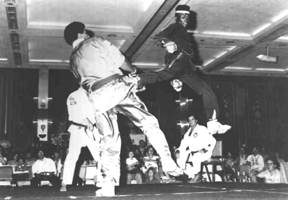 – 1978 Battle of Atlanta Middleweight Champion
– 1978 Battle of Atlanta Middleweight Champion
– Battle of Atlanta Weapons Champion
– Battle of Atlanta Forms Champion
– 1979 International Middleweight Champion Venezuela
– International Weapons Champion Venezuela
– International Forms Champion – Venezuela
– 1980 International Grand Champion Venezuela
– International Weapons Champion Venezuela
– International Forms Champion Venezuela
– 1966 – Top fighter & form competitor Knoxville Pro Am
Teachers of the Teacher:
Mr. Bob Howard: Mr. Howard was a correctional officer in Cleveland, OH. He was Mr. Cook’s first contact and instructor in the martial arts. Mr. Howard taught underprivileged children at both Cory Recreation Center and Esterbrook Recreation Center. At the time, Mr. Cook was 10 years of age and was only able to study Judo until he reached the age of 18. Mr. Howard was a brown belt in Shotokan karate, a black belt in Kodokan Judo and a brown belt in Aikido as well as being ranked in Ju Jitsu. After begging Mr. Howard consistently to teach him karate because of his small frame and the fact that he was picked on a lot in school, he finally gave in. The philosophy and basics of Shotokan were literally pounded into Mr. Cook along with a ton of self-worth.
Mr. Jake Lacey: With big black calluses protruding from the first two knuckles of each hand, Mr. Lacey was Mr. Speed. He had been stationed in Japan where he made his first contact with the martial arts. Having been in country for 3 years, engaging in an intensive training program, he attained the rank of brown belt in Shotokan Karate. His thin frame and bowlegs moved at lightning speed. At the time that Mr. Cook studied with Mr. Lacy and Mr. Story, he was 11 years of age. Mr. Cook remembers cutting school and showing up on the apartment door steps and waiting for someone to come to the door just so he could get more of the knowledge that he craved. The martial arts were slowly becoming a major part of his life. Twenty eight years later as a military policeman in Korea, Mr. Cook was fortunate enough to run into Mr. Lacey at Camp Casey in Tong Du Chon where he was a military police sergeant.
Mr. Henry Lee Story: A mild mannered individual that was a purple belt in Isshinryu karate, Mr. Story was built like a bull. His techniques were full of power along with the short close stepping of the Okinawan system. Both he and Mr. Lacy taught Mr. Cook in the back yard of there home where they were roommates. It was a daily debate between the two of them on which art was superior. Later, they both agreed that it was the man, not the art.
Mr. Clifford Yates: Mr. Yates was a career Marine who had spent a number of years in both Japan and Okinawa studying Gojuryu karate he had attained the rank of 3rd Dan. His cat like movements had been acquired from the likes of the great master Gogen (The Cat) Yamaguchi himself. When home on leave, he would stop by and bring Mr. Story and Mr. Lacy up to speed on new techniques and work with Mr. Cook on his mind set for combat and philosophy of the art.
Mr. James Yee: Mr. Yee was the father of a fellow classmate, Donald Yee. The family owned a restaurant several blocks from where Mr. Cook lived. On day, while in gym class, Mr. Cook noticed Donald off in a corner practicing kicks. When questioned, he avoided talking about it When Mr. Cook informed him of his limited experience in the martial arts and his desire to further himself, Donald spoke with his father who invited Mr. Cook to come to the restaurant. After begging Mr. Yee for several weeks, he invited Mr. Cook to practice with the rest of the family in the basement. Mr. Yee was the practitioner of Bok Mie Pai (White Eyebrow) Gung Fu. Mr. Cook’s study with Mr. Yee made his stances along with his punch a lot stronger and prepared him for what was to come later.
Mr. John Armstrong Custer: Yes. He was a descendant of the one and only and instructed in Bok Mei Pai Gung Fu. His forte was speed and agility. There were few of his students that were able to even put a hand on him. He made sure that Mr. Cook understood the importance of spees and balance and still teaches in Mr. Wally Cowper: Mr. Cowper was an exmarine who had spent time in Okinawa studying Isshinryu under the great Master Tatsuo Shimabuku. Mr. Cowper had attained the rank of 3rd degree black belt. By this time, both Mr. Lacy and Mr. Story were also studying with Mr. Cowper. In order to get into a formal karate school at that time, one had to be over the age of 17. Both Mr. Lacy and Mr. Story informed Mr. Cleveland, Ohio today.
Mr. Wally Cowper: Mr. Cowper was an exmarine who had spent time in Okinawa studying Isshinryu under the great Master Tatsuo Shimabuku. Mr. Cowper had attained the rank of 3rd degree black belt. By this time, both Mr. Lacy and Mr. Story were also studying with Mr.Cowper. In order to get into a formal karate school at that time, one had to be over the age of 17. Both Mr. Lacy and Mr. Story informed Mr. Cowper of Mr. Cook’s strong desire to continue to study the arts and finally convinced him to allow Mr. Cook to become the school mascot.
He worked his way through by sweeping and mopping after each class and painting whenever needed. Mr. Cowper was a fighter and wanted each and every one of us to be fighters too. Because Mr. Cook was the mascot, he caught the There were two very large tents set up. One was for the lower ranks and the other for the advanced students. On the side of each tent was parked an ambulance which was constantly running shuttles to and from the medical facility. Broken bones, dislodged teeth, and busted jaws were a daily thing. In each tent, there were a couple of young privates whose job it was to sweep the blood into the sand and dirt floor. When not in the field, Mr. Cook would swim across the river each morning and spend the day with some of the most dedicated men in the world. They weren’t training for competition but rather for the real deal. Mr. Cook guesses that he didn’t really understand the very soul of martial arts until he realized that this was not practice but life and death in realest sense and it is the part of his training that is at the very core of his martial arts soul.
Mr. Ku Muc Whe: Upon arrival in Korea in 1968, Mr. Cook was pleased to be introduced to Mr. Ku he was the base instructor in Taegu, Korea. The class consisted of military personnel from two of the bases there. Mr. Ku had been in Tae Kwon Do since the age of 6. His instructions included both General Choi Hong Hi and Master Dong Ju Lee. The classes were three nights a week and an hour long. At this time, Mr. Cook was a 2nd Dan and in no real hurry to add to his rank. Mr. Ku insisted that because of the time and experience that Mr. Cook had in the martial arts that within six months, he should be promoted to 3rd Dan and Mr. Cook refused. Most of the military students made black belt in a year with almost no prior training and this was to become a problem at a later date. Mr. Ku was a great instructor and drilled us constantly in forms. The majority of the students were poor fighters. After having observed Mr. Cook fight several of his top students with no problem, Mr. Ku offered Mr. Cook the position of assistant instructor, and a number of students were lost because of the rough training he dished out. Eventually, Mr. Cook made 3rd Dan and continued to assist with the classes, but he knew that there was more that he wanted to learn and do.
One of the major things that Mr. Cook learned from Mr. Ku was the art of floating in flight. He recalls in his younger days seeing photographs of black belts flying high in the air and wondering how it was possible. With consistent practice and Mr. Ku’s guidance, Mr. Cook was to become a flyer.
Mr. Jung Ho Ming: While stationed in Taegu, Korea, Mr. Cook had heard rumors of a Gung Fu group somewhere in the area but had no leads. Down the street from the Camp was a Chinese restaurant where he would eat at least three times a week. The owner and her family were intrigued by the fact that he spoke Korean so well. He inquired as to whether there were any Kung Fu instructors in the area. After about two weeks, he was informed that at the Chinese grade schoolat the end of the road, classes were being held on the roof in the evenings. An appointment was made for Mr. Cook to speak to the instructor the following day, and it was about 8:00 p.m. when he was introduced to Mr. Jung Ho Ming. Expecting to have a language problem, Mr. Cook was totally surprised when Mr. Ming spoke with a British accent. He asked Mr. Cook to demonstrate some of what he learned in the martial arts up to that point, and so he demonstrated a few forms, kicks and punches. Mr. Ming rubbed his chin and asked Mr. Cook to come back the following week. Returning a week later, he was only told to return in another week. It was like something out of a martial arts movie. The went on for almost a year when Mr. Cook was informed that he would be returning to the United States as his tour of duty was over. When he informed Mr. Ming of this, his reply was, If you truly wish to learn, then I will see you again. After a year and a half at Ft. Bragg, NC as a military policeman and base instructor, Mr. Cook reenlisted to return to Korea. Upon his arrival in Taegu, he found Mr. Ming and was accepted as a student. The classes were about 2 hours long per night and were held twice a week.
There was very little emphasis on fighting but the form training was intense. Mr. Ming left Korea and moved to China leaving Mr. Cook with two of his assistants to be his private trainers. They were young and spoke no English but with the background that he had acquired, there was nothing that Mr. Cook did not understand in the training.
Mr. Chun Gwong Ho: Mr. Chun was a scrapper that grew up on the mean streets of Korea and found himself in an out of trouble with the law as a teenager. He began his martial arts studies under Grandmaster Wang Ju Won the President of the Korean/Chinese Gung Fu Association. Hi knowledge of form and weapons was endless. Ranked 6th degree in Praying Mantis Gung Fu, his method of teaching was definitely old school Leaving the class in a horse stance for long periods of time, he was heartless when it came to basic forms. Hundreds of repetitions were required before moving on to the next form. Quite frequently, a bamboo sword was used on an arm or leg to remind you that something was wrong with your position.
Whe Jung (Grandmaster Wong Ju Won): Mr. Wong Ju Won was the product of a Chinese father and a Korean mother. His education in the martial arts started almost at birth. Training from his Chinese background in the art of Northern Praying Mantis made him the perfect candidate to unify the Chinese and Koreans. It also made him the target in the center of a society that was Tae Kwon Do oriented. His students all over Korea fought a daily battle with the Tae Kwon Do regime.
Pound for pound, he was one of the most powerful men Mr. Cook has ever met. He once saw him strike a support pole in the center of the school with his forearms and shake dust form the entire building. He saw him dip his hands in gas and set them on fire without a flinch. From Mr. Won and Mr. Chun, Mr. Cook learned to use the mind to set him free of a million fears and open a million doors. Mr. Ron Shaw: Mr. Shaw was one of the smartest and fastest fighters that Mr. Cook ever met. In 1972, Mr. Cook was sent from Korea back to the United States due to an illness in his family. While home on leave, he had the opportunity to meet Mr. Shaw at a local dojo. Mr. Shaw was the brother of an old schoolmate who had made a great name for him in the martial arts. He was responsible for helping Mr. Cook make the transition into the world of competition and taught Mr. Cook the tricks of the trade as far as using his years of training and adapting them to the tournament circuit. A 3rd degree in Isshinryu, his lightning ability to cover distance in the blink of an eye, was passed on to Mr. Cook as one of the greatest gifts he ever received.
Grandmaster Ed Parker: Mr. Parker was a teachers teacher. His ability to convey his teachings and concepts was uncanny. From this great man, Mr. Cook learned so much more about the art of teaching. His humor coupled with his knowledge was his greatest to. His background in the martial arts was rooted in the old school and reflected in each and every student that he ever produced. Mr. Parker along with Mr. Robert Trias was truly pioneers in martial arts, as we know it today in the United States.
Grandmaster Robert Trias: From the first time Mr. Cook heard the names of Bill Wallace, Artis Simmons, Phillip Koeppel and many more, he wondered where these great fighters were coming from. In 1968, Mr. Cook found out. He joined the United States Karate Association and the ranks of some of the top fighters in the world. This was just the beginning of a career that would pit him against the best. The head of this organization was non other than the Great Master Robert Trias. The United States Karate Association consisted of members from all styles and systems of martial arts. Mr. Cook’s biggest dream was to one-day wear the Trias International Patch. This was the badge of honor and the top award granted only to those who had proven themselves. It was a society of the best of the best and Mr. Cook wanted it bad. Master Trias often encouraged Mr. Cook to keep fighting and never give up on his dream. On June 17th, 1978, one year after winning the Grand Nationals, Mr. Cook’s dream came true. With an overwhelming vote of the membership and the blessing of Master Trias, he was voted in.
Taken from the Trias Int’l Society Member Profile of Mr. James S. Cook Jr.


